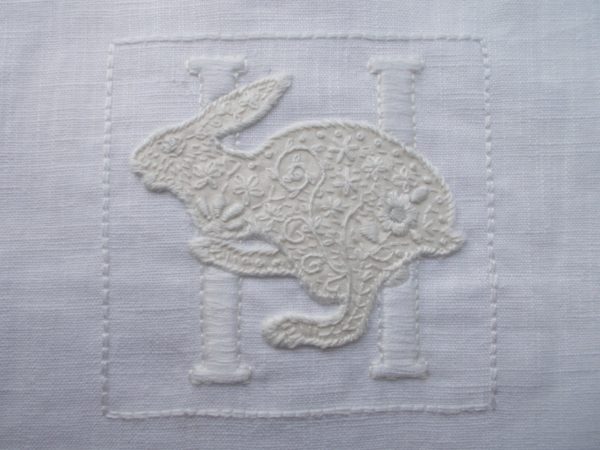
A whitework alphabet: letter H (hand embroidered by Mary Addison)
Oh the bliss of returning to knitting and sewing after a summer spent surrounded by storage boxes, their half forgotten contents and random bits of household furnishings – my welsh grandmother’s brass kettle (which I can neither give away nor know what to do with), an iron curtain rail for a rather large bay window (now cut down by a local blacksmith for our sitting room window) and Chinoiserie lamp bases I’d like to use but don’t have room for (to be kept as, in line with Marie Kondo’s test, they give me joy). Happily, many other things have found an immediate home. A little girl in London now enjoys not one, but two dolls’ houses, (one upstairs and one down, gratis her two maternal aunts) – in a house with so many stairs, a real blessing. Boxes of Sylvanian Families (rhino, leopard, gorilla, fox, tiger and frogs), 20 plus years old but in mint condition and still in their boxes, are equally welcome, though we are rationing their appearance – possibly over several years! And that Vileda mop handle tucked away in a corner is eagerly awaited in London where two mop head replacements bought in error lie temporarily useless. Six white bowls and the odd jug or two will also be absorbed into the London kitchen. Sometimes not throwing things away is so gratifying! Anyway the gist is that the end is in sight and our garage, industrial shelving down both long sides, is very nearly the thing of wonder I have spent sleepless bits of nights fantasising about. Ahhhh. Modified delight.
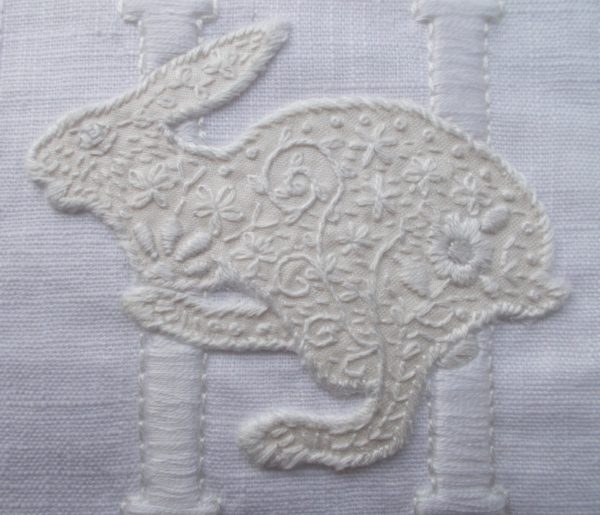
A whitework alphabet: letter H (hand embroidered by Mary Addison)
Back to the whitework alphabet, here is H for Hare – only the hare is racing so fast in front of the H that you have to imagine a large part of the letter! John Lewis-Stempel has written movingly about them in The Running Hare (2016). Even more exciting, he has a new book just out called The Private Life of the Hare (2019). A farmer, trying to farm in the ways of the past, he set about trying to encourage hares on his land. Unlike me he has seen them up close and has formed a vivid impression of their singular appearance.
“…a jack hare, rocking-chair gait peculiar to the species. He stops and glares with golden eyes. Hares have the chiseled head of horses, the legs of lurchers and the eyes of lions.”
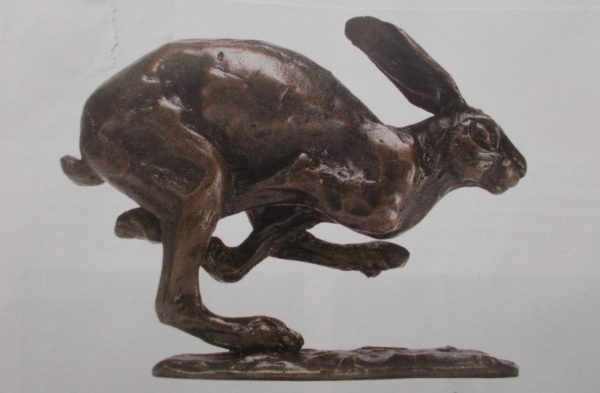
Bronze hare by Sue Maclaurin
He held one once when it had become entangled in sheep netting, needing of all his rugby-playing strength to keep a grip and block out the pain. Yet what does he remember but the soft velvet feel of this most undomesticated of animals. I say undomesticated yet, extraordinarily William Cowper, the C18th poet, kept 3 as pets. Having suffered several mental breakdowns, he found the animals, which came individually to him as abandoned leverets, a solace and comfort, a sort of animal Prozac, their presence in his cottage raising his spirits to such an extent that he was able to write again and even produce his best work (“The Task”). He built little wooden rooms with litter trays beneath for each hare to retire to at night but in the day time they had the run of the house, particularly enjoying dancing on the turkey carpet. I seem to remember reading in one of these books (probably The Running Hare, which daughter No 1 got interested in and took back to London with her) that one of the hares would even sit on his knee, look him in the eye and tell him when he wanted to go out. It’s no coincidence that one of the three was called Puss.
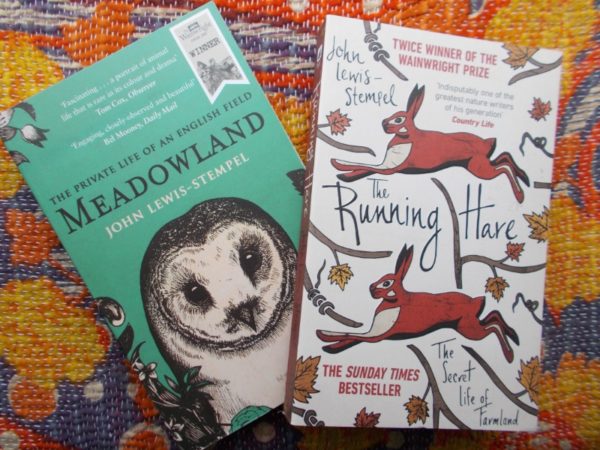
John Lewis-Stempel’s books.
Meadowland & The Running Hare
“the countryside of England, before the depredations of agri-business from the 70s onwards, was a sort of heaven, running with hares. I just want it back.” A hill farmer, with sheep and no crops, he has a desire to see arable land farmed in the old way. In The Running Hare he takes on a short term tenancy of a smallholding to see what he can achieve. He has just one year to put a field to growing wheat and permitting wild flowers and wild animals in the arable, for in the second year he has to return it to grass. Read the book and see how successful he was. Whether farmers en masse can – or would want to – do what he did is to open a Pandora’s box of speculaltion.
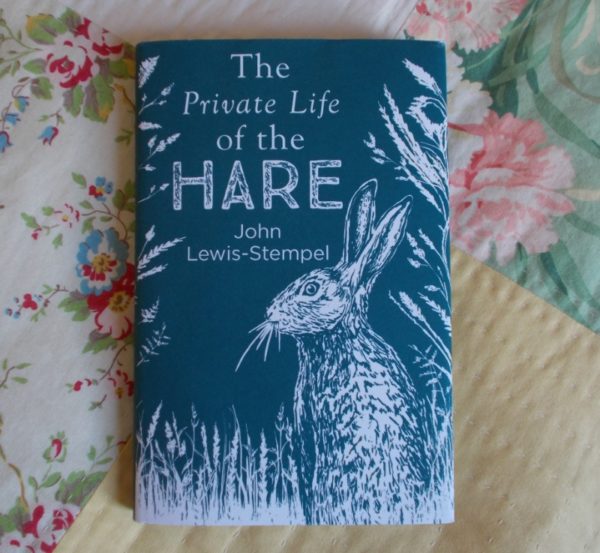
John Lewis-Stempel: The Private Life of the Hare (pub. Oct 2019)
Whatever the farmer in Ipsden was doing he must have been doing something right, for there were hares in the field behind us. I’ve never got close to them but we used to see them from the vicarage window, though only ever in the snow when they’d leap around energetically for a while and then sink back into the snow and then stay like that immobile for hours, small smudges of brown in the sea of white, usually two adults and a younger animal. Their home, called a form, was no more than an indentation in the earth, usually between ploughed furrows. Practically as soon as they’re born leverets have their own form and are visited by their mother for suckling once a day. It seems such a precarious existence, particularly when you think the fields are full of those alpha predators, foxes and the skies above the Chilterns are flooded with Red Kites. Our tiny Cheltenham garden is a delight but though there’s lots of greenery, there’s no wildlife … and hardly any birds. It’s swings and roundabouts. Here we hardly ever use the car and walk everywhere. In the country, you went FOR a walk but almost anything else – going to work, shopping, going to church, meant getting in a car. Now the most basic aspects of life require evaluation and introspection.

20 Comments
So lovely to have you back Mary. An inspirational tale of order imposed!. And how is the quilt?
What a lovely thing to say. Thank you.
The quilt is still with the quilter. As soon as it returns, I will let you know.
So good to hear from you again! And such a poetic post, too (not just because of Cowper). There’s a hare called “Serena” in Elizabeth Goudge’s “The Little White Horse”, and I’m sure she chose a hare rather than a rabbit because of their wildness…
Thank you Rachel, it’s good to be back to the routine of sewing and writing once more.
I keep thinking I’ve read “The Little White Horse” but can remember nothing about it, so maybe I haven’t.
Rabbits and hares are so very different. Hares, being nocturnal, mainly solitary and with unusual habits, have historically been associated in folk tales with the moon. But, as you say, they are most definitely wild animals, in a way that bunnies aren’t.
Goodness, Mary, I have missed reading your wonderful blog. I have checked most days to see if you had returned. Like Linda above, I too have been wondering about the quilt. Lovely to have you back and thank you for another inspiring post.
I’m hoping to hear about the quilt in the not too distant future, but meanwhile there seems plenty of other things I’m desperate to do.
Really thoughtful of you to let me know you’ve missed the blog. Thank you.
So happy to see you posting again and enjoying the reorganization of your storage. A job that’s so difficult for all of us especially the part of not having a place to use the item but not wanting to move it on either!
It’s a very good feeling having had a massive sort out, but the best thing is that now I can get back to the things I enjoy doing without feeling there’s something else I should be getting on with.
So happy to see you’re back. Glad you survived the reorganization. I now feel inspired to read some Cowper, I have a particularly beautiful old edition liberally decorated with woodcuts.
Look forward to hearing about the quilt.
Yes, Anne I rather fancy a bit of Cowper too – your edition sounds just right for a winter read.
How nice to hear that you have progressed on a daunting task (and to learn that your blogging absence was caused by productivity elsewhere vs something dire). The flower covered hare is wonderful, worth the wait to create and enjoy.
ceci
Glad you like the hare Ceci.
More work still needed on the reorganisation but somehow I have a feeling the call of garage tidying is already getting dimmer as the clocks have gone back and the nights have drawn in. Still, at least we’re not paying for the storage now!
Glad to see you back, and congrats on reaching your reorganizing goal!
Goal not fully reached but all is liveable withable until Spring!
Thank you for being glad I’m back blogging.
I only found your blog for your “G” ………….. and then no more for several months. So happy to see that it is still active and look forward to future updates.
Welcome Phil. Thank you for dipping in.
It makes me sad I don’t see more wildlife than I do. We live in the western United States, in Utah, and there are large tracts of forest and field all around, but few animals. I’m learning to take more pleasure in the birds I see at least.
I’m really shocked that you see so few animals in Utah, which I’d always assumed to be such a wild natural place. Glad you do have birds to enjoy.
It could be the trails I am using have too many people on them, and I have had a few wonderful encounters seeing mink and badgers and weasels. But no, not a lot of mammals.
Badgers and weasels sounds good. Not sure about the mink. They’re exotic to us and where well-meaning people have released them into the wild here, they’ve been disastrous to indigenous species. Nature is so complicated nowadays!